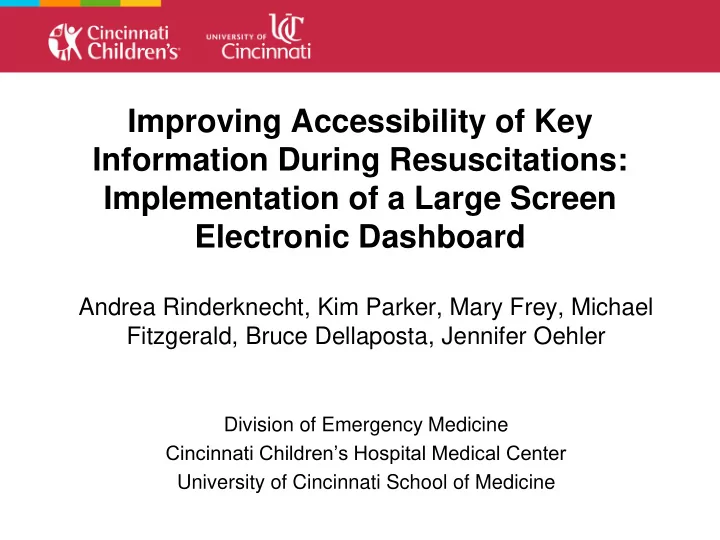

Improving Accessibility of Key Information During Resuscitations: Implementation of a Large Screen Electronic Dashboard Andrea Rinderknecht, Kim Parker, Mary Frey, Michael Fitzgerald, Bruce Dellaposta, Jennifer Oehler Division of Emergency Medicine Cincinnati Children’s Hospital Medical Center University of Cincinnati School of Medicine
Disclosures The authors have no financial relationships to disclose or conflicts of interest to resolve.
Background: ED Resuscitations
Background Team leading during resuscitations • High cognitive load • Situational awareness • Communication
Current System
Project Goal Improve access to key data during resuscitation
Requirements of Solution • Leverage existing technology • Display key data from multiple sources • Easily visible / digestible format • Require minimal (or no) user interaction
Test System
Front Screen Capabilities Capabilities – Front Screen
Front Screen – Video Laryngoscope Output
Rear Screen Capabilities
Study Objective Assess provider perception of accessibility of key data prior to and after implementation of the large screen electronic dashboard
Methods • Setting – Resuscitation suite – High volume ED – L arge, tertiary care children’s hospital • Patients – Critically ill – Medical and Traumatic etiologies
Methods • Custom-designed survey (Qualtrics) – Respondents • MD team leaders • RN team leaders – Primary outcome • Perceived accessibility of key data during resuscitations – Secondary outcomes • Perceived importance of key data during resuscitations • Reason for perceived importance • Statistical Analysis – Paired samples t-tests to compare mean differences
Primary Outcome Accessibility of Data Elements Vital Signs Lab results • Current • Point of care • Previous • Sent to Lab • Trend Duration of Resuscitation Radiographic studies • Time since start • Image available • Reading available Medications Procedures • Name • Procedures performed • Dose administered • Time since procedure • Time since dose performed • View of ETT passing vocal administered cords during Intubation
Results • Test Period: Jan 12 – Mar 16, 2015 Inclusion Patients Length of MD Providers RN Team Leader (including 3 rd Criteria Seen in Stay Providers Test (Range in year fellows) Bay Min) Medical, 271 8 - 185 40 38 Trauma Alerts and Trauma Stats • Completion of survey – 21/45 (47%) eligible MDs – 12/25 (48%) eligible RNs
Secondary Outcomes • Perceived importance of data elements – Mean scores > 4 for all • Except time elapsed since the start of the resuscitation – Scale: 1-6 • 4 = Important • 5 = Very Important • 6 = Essential
Secondary Outcomes • Impact of data accessibility – Timeliness of decisions – Situational awareness – Ability to assess patient • “KEEP IT” – 100% of respondents – NO changes – 35% – MINOR changes – 63% – MAJOR changes – 2%
Limitations • Method – Survey: not validated • Improvement noted in data not expected to improve – Current Vital Signs – Number of doses of medication given – Overall improved situational awareness and decreased cognitive load? • Outcomes chosen – Provider satisfaction – Did not measure outcome on patient • Very difficult to study – Heterogeneity and rarity of presentations – Selection of measures / outcomes – Time / Resource Intensive
Conclusion The development and implementation of a large screen electronic dashboard significantly improved physician and nursing team leaders’ perception of accessibility of key data required during resuscitative care.
Next Steps • Improving our solution • Install in remaining resuscitation bays?
Acknowledgements • Kim Parker • Mary Frey, MSN, RN, CNL, CPN, CPEN • Michael Fitzgerald, PhD • Bruce Dellaposta, Ed.D., LSSMBB • Jennifer Oehler, MSN, RN • Margot Daugherty, RN
Questions
Projected cost per Bay • < $20,000 – 2 large screen LEDs – 2 processor systems – Cable, HDMI plate, other equipment – Mouse and pad controller – Construction costs • Priceless – CCHMC EPIC analyst time and effort to customize and interact with EPIC to perfect / improve system
Our Team • Multidisciplinary input – PEM physician – Experienced RN team leader – EPIC analyst – Trauma services RN – Quality improvement experts – Parent Advisory Committee
Perceived importance of Key Data
Reasons for Perceived importance
Background – Our Story • Setting - CCHMC Emergency Department (ED) – Total Volume (annual) ~100,000 patient encounters – April 1, 2014 – March 31, 2015 • ED – 62,991 • Resuscitation Suite – 3,753 (6%) – Medical – 2095 (56%) – Trauma Alert or Stat – 402 (11%)
Resuscitation Team Make-up • MDs – PEM Team Leaders (45) – Bedside MDs (Residents – Pediatric, EM, Family) – Trauma Surgery (Resident, Fellow, Attending) • RNs – Trauma Core RN Team leaders (38) – Bedside, Medication RNs • Additional (integrated and ad hoc) – Paramedics – Patient Care Attendants – OR Staff – Anesthesia
Improving the Availability of Data Key Driver Diagram (KDD) Project Leader(s): Andrea Rinderknecht, MD Mary Frey, RN Revision Date: 3/19/2015 Interventions (LOR #) Key Drivers Accumulation of data over Add staff resources to gather and time communicate data (LOR 1) SMART Aim Clear communication Integrate STS dashboard (LOR 2) Increase the % of survey respondents Improve team leader cognitive who selected easy on Appropriate team make-up capacity (LOR 1) the accessibility to key data in STS from X to Y using a pre and Implement a BPA/reminder to review Appropriate utilization and post-survey by 5/1/15 vitals every 5 minutes (LOR 2) maximization of technology Population: ED MD and Create a communication board as a Accumulation of data from RN team leaders patient log (LOR 1) multiple sources Global Aim Remove barriers to data entry/display Limitations of current (LOR 1) technology Improve safety, quality, and reliability of care for STS patients Key Gray shaded box = completed intervention Green shaded box = what we’re working on right now LOR # = Level of Reliability Number, e.g., LOR 1
Resuscitation Suite Documentation • Electronic Medical Record – November 2012 • Improved documentation (more detailed) • Negative effect on RN team leader’s capacity to co -team lead
Recommend
More recommend